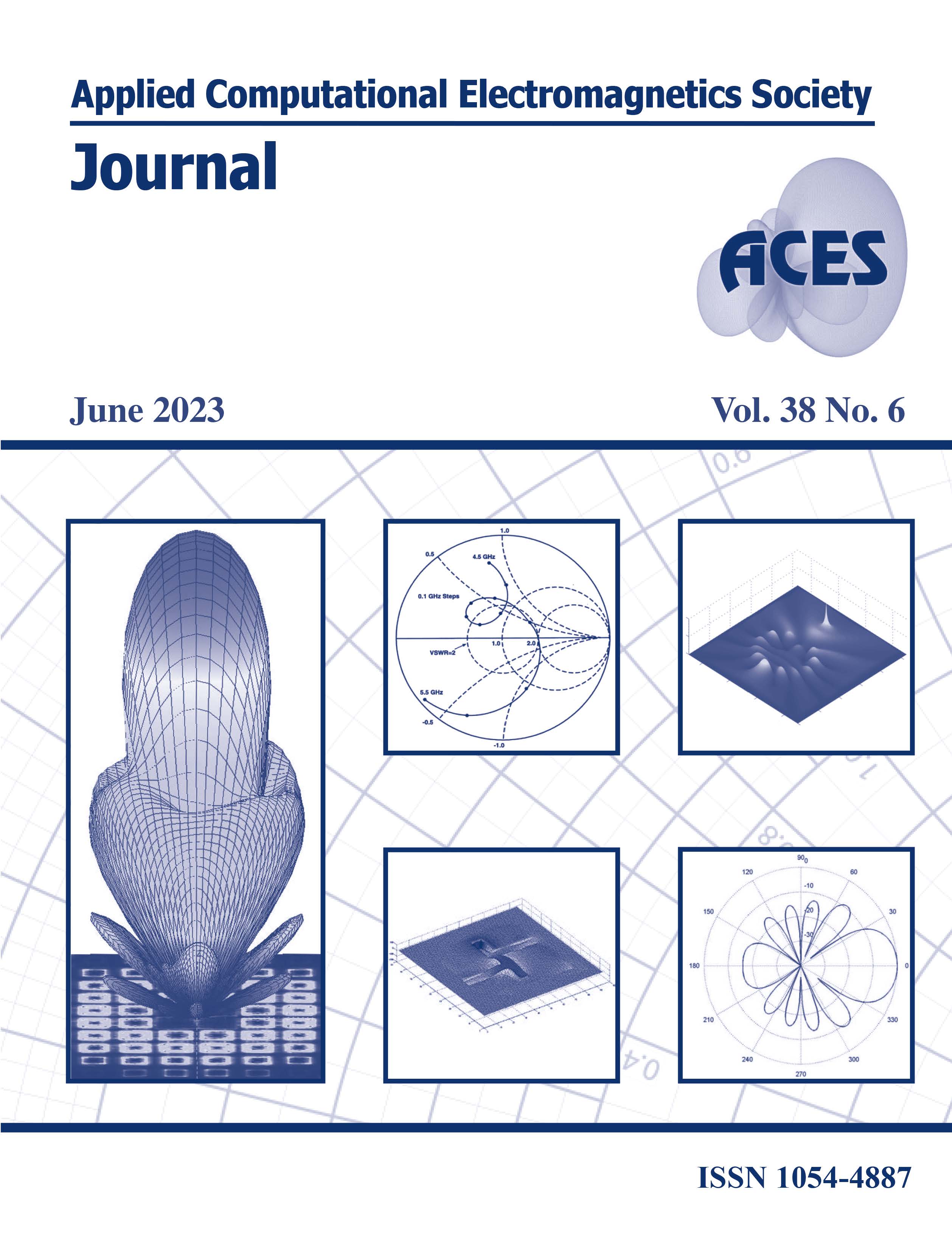CMOS High Swing and Q Boosted Dual Core Voltage Controlled Oscillator for 5G New Radio Application
DOI:
https://doi.org/10.13052/2023.ACES.J.380610Keywords:
cascode, CMOS, cross-coupled pair, 5G, New Radio, Q enhancement, switched varactor array (SVA), Voltage Controlled OscillatorAbstract
This paper describes a low power, low phase noise CMOS voltage controlled oscillator (VCO) with a cascoded cross-coupled pair (XCP) configuration for high data rate 5G New Radio (5G-NR) applications. The core consists of a primary auxiliary VCO built as a negative conductance circuit to improve phase noise and a secondary core with a cascoded formation to increase output voltage swing. A switched varactor array (SVA) wideband tuner is integrated for a wide bandwidth application in a low power implementation. The dual-core VCO was designed in CMOS 130 nm technology and occupies only 1.05 mm2 of space. With a supply voltage of 1.2 V, the VCO achieved a tuning range of 32.43% from 3.45 GHz to 4.47 GHz. At 3.96 GHz carrier center frequency with 1 MHz offset, the total power consumption is 0.7 mW with a corresponding phase noise (PN) of −121.25 dBc/Hz and a Figure of Merit (FoM) of 193.25 dBc/Hz. The results are validated using Cadence Spectra RF simulations.
Downloads
References
M. Shahmohammadi, M. Babaie, and R. B. Staszewski, “Tuning range extension of a transformer-based oscillator through common-mode Colpitts resonance,” IEEE Trans. Circuits Syst. I, Reg. Papers, vol. 64, no. 4, pp. 836-846, Apr. 2017.
D. Hauspie, E. C. Park, and J. Craninckx, “Wideband VCO with simultaneous switching of frequency band, active core and varactor size,” IEEE J. Solid-State Circuits, vol. 42, no. 7, pp. 452-455, July 2006.
O. El-Aassar and G. M. Rebeiz, “A dual-core 8-17 GHz LC VCO with enhanced tuning switch-less tertiary winding and 208.8 dBc/Hz peak FoMT in 22nm FDSOI,” IEEE Radio Frequency Integrated Circuits Symposium (RFIC), Los Angeles, CA, USA, pp. 247-250, Aug. 2020.
Y. Luo, C. Ma, Y. Gan, M. Qian, and T. Ye, “A dual-band CMOS LC-VCO with highly linear frequency tuning characteristics,” Microelectronics J., vol. 46, no. 12, pp. 1420-1425, June 2015.
H. Amir-Aslanzadeh, E. J. Pankratz, C. Mishra, and E. Sanchez-Sinencio, “Current-reused 2.4-GHz direct-modulation transmitter with on-chip automatic tuning,” IEEE Trans. Very Large Scale Integr. Syst., vol. 21, no. 4, pp. 732-746, Apr. 2013.
M. Fang, A. Kumura, and T. Yoshimasu, “A 210.4-dBc/Hz FoMT 67.9% tuning range LC-VCO IC with a single analog voltage-controlled novel varactor in 40-nm CMOS SOI,” IEEE International Symposium on Radio-Frequency Integration Technology, Hualien, Taiwan, pp. 2021-2023, Aug. 2021.
B. Park, S. Lee, S. Choi, and S. Hong, “A 12-GHz fully integrated cascode CMOS LC VCO with Q-enhancement circuit,” IEEE Microwave and Wireless Components Letters, vol. 18, no. 2, pp. 133-135, Feb. 2008.
H. Kim, S. Ryu, Y. Chung, J. Choi, and B. Kim, “A low phase-noise CMOS VCO with harmonic tuned LC tank,” IEEE Trans. Microw. Theory Tech., vol. 54, no. 7, pp. 2917-2923, July 2006.
B. D. Williamson, “A 2.4 GHz LC-VCO using on-chip inductors and accumulation-mode varactors in a CMOS 0.18 μ
m process,” Master’s thesis, University of Tennessee, Knoxville, TN, 2005.
S. Chatterjee, Y. Tsividis, and P. Kinget, “0.5-V analog circuit techniques and their application in OTA and filter design,” IEEE J. Solid-State Circuits, vol. 40, no. 12, pp. 2373-2387, Dec. 2005.
M. Fang and T. Yoshimasu, “A -197.3-dBc/Hz FoMT wideband LCVCO IC with a single voltage-controlled IMOS-based novel varactor in 40-nm CMOS SOI,” IEEE Trans. Microw. Theory Techn., vol. 68, no. 10, pp. 4116-4121, Oct. 2020.
T. Azadmousavi and E. N. Aghdam, “A low power current-reuse LC-VCO with an adaptive body-biasing technique,” AEUE - Int. J. Electron. Commun., vol. 89, pp. 56-61, May 2018.
T. Siriburanon, W. Deng, K. Okada, and A. Matsuzawa, “A current-reuse Class-C LC-VCO with an adaptive bias scheme,” IEEE Radio Frequency Integrated Circuits Symposium (RFIC), Seattle, WA, USA, pp. 35-38, June 2013.
S. Ikeda, S. Lee, H. Ito, N. Ishihara, and K. Masu “A 0.5 V 5.96-GHz PLL with amplitude-regulated current-reuse VCO,” IEEE Microwave and Wireless Components Letters, vol. 27, no. 3, pp. 302-304, Mar. 2017.
V. J. Higgins, F. A. Brand, and J. J. Baranowski, “Characteristics of varactor diodes biased into avalanche,” International Electron Devices Meeting, Washington, DC, USA, pp. 14-14, Oct. 1965.
C. Sánchez-Azqueta, J. Aguirre, C. Gimeno, C. Aldea, and S. Celma, “High-resolution wide-band LC-VCO for reliable operation in phase-locked loops,” Microelectronics Reliability, vol. 63, pp. 251-255, Aug. 2016.
M. Garampazzi, P. M. Mendes, N. Codega, D. Manstretta, and R. Castello, “Analysis and design of a 195.6 dBc/Hz peak FoM P-N class-B oscillator with transformer-based tail filtering,” IEEE J. Solid-State Circuits, vol. 50, no. 7, pp. 1657-1668, July 2015.
Y. Peng, L. Zhou, Y. Yu, H. Liu, Y. Wu, C. Zhao, H. Tang, and K. Kang, “A harmonic-tuned VCO with an intrinsic-high-Q F23 inductor in 65-nm CMOS,” IEEE Microwave and Wireless Components Letters, vol. 30, no. 10, pp. 981-984, Oct.2020.
C. H. Chun, H. S Choi, Q. D Bui, S. Y Kang, J. Y Jang, U. B. Lee, I. Y. Oh, and C. S. Park, “Compact wideband LC VCO with active inductor harmonic filtering technique,” Electronic Letters, vol. 47, no. 3, pp. 190-191, Feb. 2011.
J. Du, X. Zhang, C. Zhang, F. Meng, and N. Yan, “An ultra-wideband VCO using digitally controlled varactor arrays in 40-nm CMOS technology,” IEEE MTT-S International Wireless Symposium (IWS), Nanjing, China, pp. 1-3, May 2021.
P. Shasidharan, H. Ramiah, and J. Rajendran, “A 2.2 to 2.9 GHz complementary class-C VCO with PMOS tail-current source feedback achieving -120 dBc/Hz phase noise at 1 MHz offset,” IEEE Access, vol. 7, pp. 91325-91336, July 2019.




